The World of Cat Mating: Understanding Feline Courtship and Reproduction
The World of Cat Mating: Understanding Feline Courtship and Reproduction
6. Spaying and Neutering:
like comment share
Introduction:
Cats, those mysterious and independent creatures, have a unique and intriguing mating behavior that is worth exploring.
In this blog post, we'll delve into the intricacies of cat mating, shedding light on the courtship rituals, reproductive processes, and the role of feline instincts in this fascinating aspect of their lives.
In this blog post, we'll delve into the intricacies of cat mating, shedding light on the courtship rituals, reproductive processes, and the role of feline instincts in this fascinating aspect of their lives.
1. The Mating Rituals:
- Cats are known for their elaborate courtship rituals, often involving behaviors such as vocalizations, body postures, and scent marking.
- Male cats may exhibit a series of behaviors to attract a female, including yowling, grooming, and presenting gifts such as food.
- Female cats, on the other hand, may become more affectionate and may vocalize to signal their readiness to mate.
2. The Role of Hormones:
- Hormones play a crucial role in cat mating.
Female cats typically go through an estrous cycle, commonly known as being "in heat," where they become receptive to mating.
Female cats typically go through an estrous cycle, commonly known as being "in heat," where they become receptive to mating.
- Male cats produce pheromones to attract females, and the scent marking becomes more pronounced during the mating season.
3. The Act of Mating:
- Once the courtship is successful, mating occurs.
It is a relatively quick process, often involving the male biting the female's neck to hold her in place.
It is a relatively quick process, often involving the male biting the female's neck to hold her in place.
- Female cats may vocalize during mating, which is a natural response to the male's actions.
4. Gestation and Pregnancy:
- The gestation period for cats is approximately 63 days.
During this time, pregnant cats may exhibit changes in behavior and appetite.
During this time, pregnant cats may exhibit changes in behavior and appetite.
- Proper care and nutrition are essential for pregnant cats to ensure the health of the mother and the developing kittens.
5. Birth and Maternal Care:
- After the gestation period, female cats give birth to a litter of kittens.
The mother provides essential care, including nursing, grooming, and protection.
The mother provides essential care, including nursing, grooming, and protection.
- Understanding the maternal instincts of cats helps in creating a conducive environment for the mother and her kittens.
6. Spaying and Neutering:
- Responsible pet ownership often involves spaying and neutering to control the feline population and prevent unwanted behaviors related to mating.
- Discussing the benefits of these procedures can contribute to the overall well-being of cats and their owners.
Conclusion:
Exploring the world of cat mating unveils a realm of instincts, behaviors, and biological processes that add to the charm of these enigmatic creatures.
By understanding and appreciating the intricacies of cat mating, we can enhance our connection with our feline friends and ensure their well-being in a domestic setting.
By understanding and appreciating the intricacies of cat mating, we can enhance our connection with our feline friends and ensure their well-being in a domestic setting.
thanks
see you again.


Comments
Post a Comment